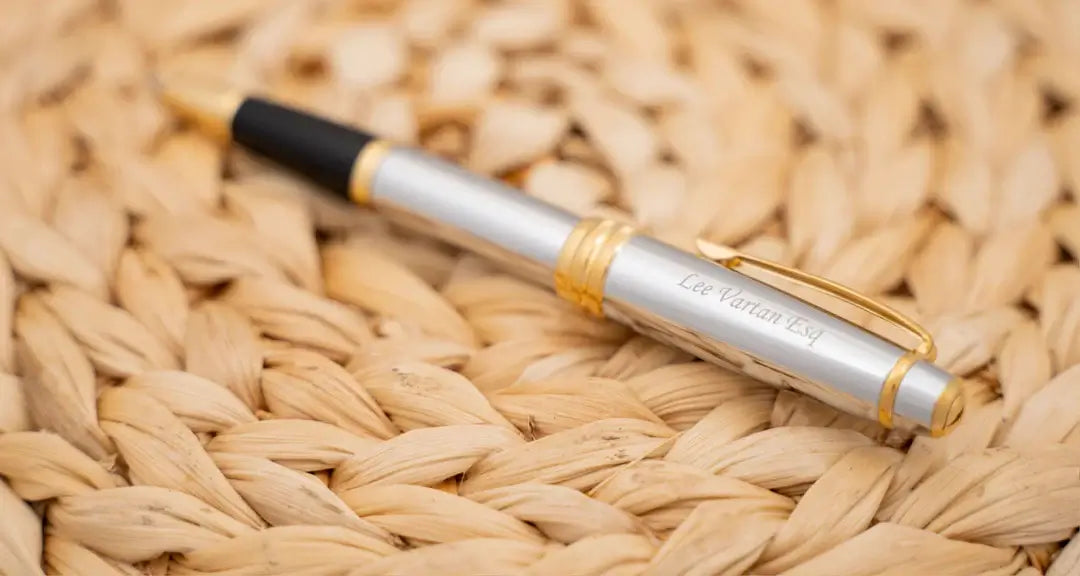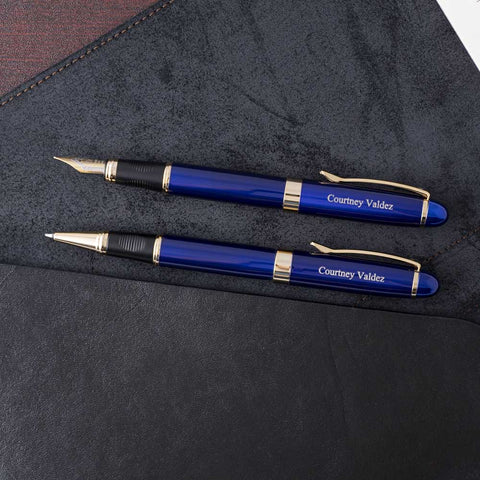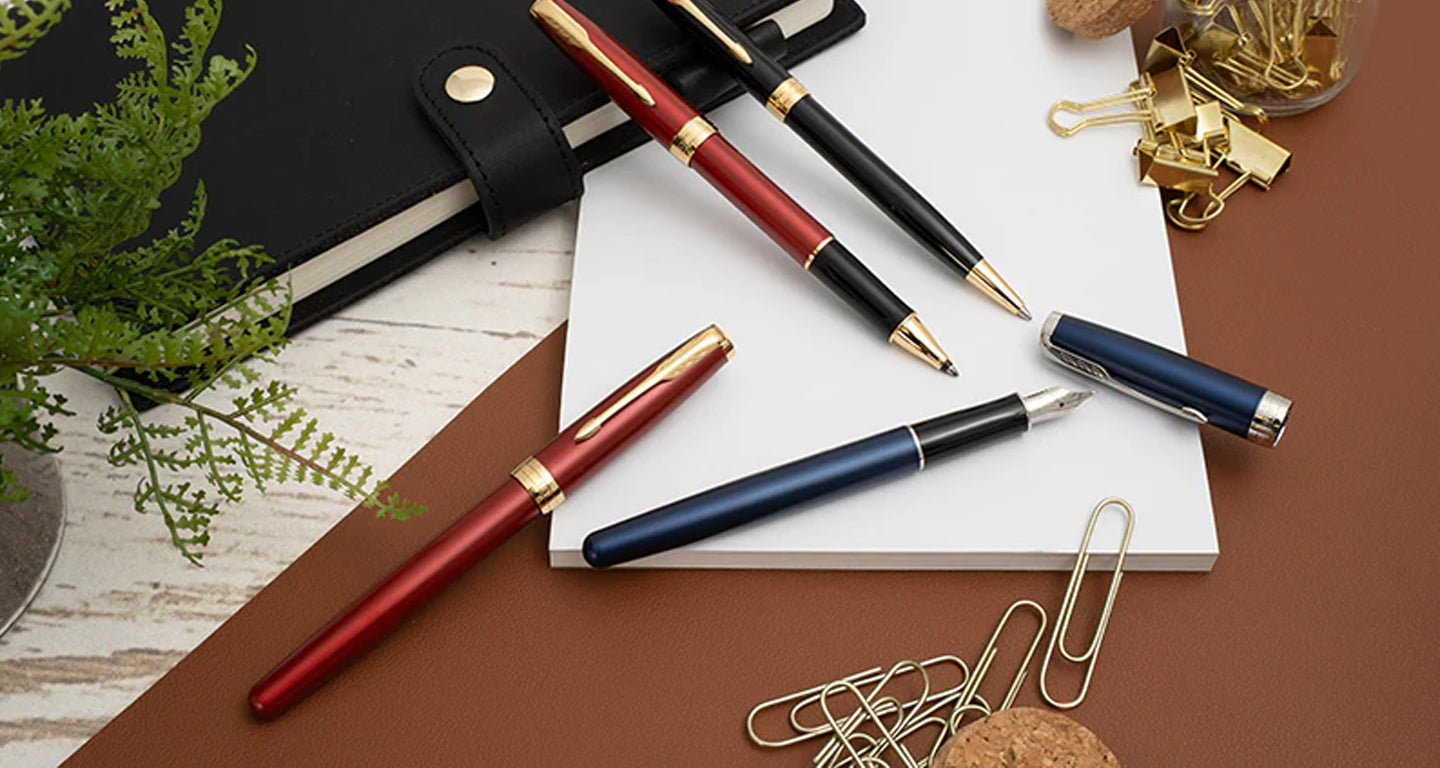
What Is a Rollerball Pen?
Rollerball vs ballpoint: what's the difference?
You've likely used the Pilot G-2, the Uni-ball Vision, or the Pentel Rolling Writer without realizing their type.
In this article, I'll answer the question what is a rollerball pen, how it works, and its pros and cons.
Starting from the top!
What is a Rollerball Pen?
A rollerball pen is a writing instrument that uses a ball-and-socket mechanism to transfer liquid ink from a cartridge to a writing surface.
A rollerball pen combines aspects of both the fountain pen and the ballpoint pen in one simple design. This is due to the rollerball ink being liquid-based as a fountain pen, while using the same writing mechanism as a ballpoint pen.
Let's get into the details of how rollerball pens work and what makes them a useful writing instrument.
How Does a Rollerball Pen Work?
Similar to a ballpoint pen, a rollerball uses a small rotating ball in the tip of the pen to dispense ink onto your paper when you’re writing.
The ball is usually made of steel or Tungsten carbide. It’s secured within a socket that is, in turn, connected to the ink reservoir within your pen’s barrel.
As the pen's metal ball rotates, the ink is transferred onto your paper surface.
Rollerball pens use water-based ink that has a low viscosity. As a result, the ink flows from the internal ink reservoir quickly with little resistance, resulting in a smoother writing line.
So what makes the rollerball pen different from a ballpoint pen?
Rollerball vs Ballpoint: What Are the Differences and Similarities?
The only major difference between the ballpoint pen vs rollerball pen lies in the type of ink used in the pen; ballpoint pens use thick oil based ink, while rollerball pens use liquid-based ink.
High viscous inks like ballpoint ink significantly impact the difference between writing with ballpoint pens vs rollerball pens, especially in the amount of pressure you need to apply while writing.

Ballpoint pen ink requires a significant pressure to transfer the thick oil based ink from the ball to the paper, while liquid ink requires less pressure as the ink flow rate is higher and the paper draws on the ink.
However, aside from the ballpoint pen ink, a user will find rollerball pens share a shocking number of similarities to ballpoint pens.
The Writing Mechanism
As has been touched on, the biggest commonality between the ballpoint pen and the rollerball pen is the small revolving ball mechanism that transfers viscous ink to paper.
Whether the pen types specify oil based ink, gel based ink, or water based liquid ink, they all still use the same medium to write.
Low Maintenance
Ballpoint and rollerball pens both minimal to no upkeep. Indeed as far as writing instruments go, you simply need to uncap or eject the point to write.
Tip Consistency
Like a ballpoint pen, the fixed ball at the tip of a rollerball pen always remains round. This means the width stays the same when you write.
Convenience
Rollerball pens are either refillable or disposable.
A disposable rollerball pen will offer a single use experience similar to a standard ballpoint pen like the Stic Bic.
Refillable rollerball pens are very common (even the Pilot G-2 is a refillable pen). In this instance, when the pen's ink flow stops the ink cartridge can be replaced and the barrel of the pen reused.
There are no extra complicated steps you need to take to refill your pen.
| Discover More: 20 Best Rollerball Pens to Give as Gifts |
Just like you can't talk about rollerball pens without talking about ballpoints, so too the connection between the rollerball and the fountain pen must be discussed.
What Are the Differences and Similarities Between Rollerball Pens and Fountain Pens?
The major difference is of course the tip of the writing instruments; the fountain pen has a pointed nib, while the rollerball has a roller ball point.

Though the differences are obvious, the similarities are pivotal to what makes a rollerball pen unique.
Water-Based Ink
Rollerball pens use water-based that originated from fountain pens.
The main advantages of water-based liquid rollerball ink include:
-
More ink flows onto the paper. This allows for more defined colors and, in turn, better contrast.
-
Smooth writing experience. Because of the ease of flow, less pressure is required when writing.
-
Liquid ink comes in a wide range of colors. This is made possible by the huge variety of water-soluble pigments and dyes.
-
The smooth flow of water-based inks makes them ideal for writing fine and tight-knit lines.
Different Tip Sizes
Unlike ballpoint pens that are predominately the same tip size, rollerball pens specialize in varying tip sizes just like fountain pens.
This is a defining characteristic of the rollerball pen and the fountain pen as point size or nib size as can be seen when purchasing either pen types.
Whether a buyer is looking for a rollerball pen or a fountain pen, the point size will always be specified on the packaging. Rollerball pens tend to use millimeters to distinguish point size, while fountain pens will state fine, medium, or broad.
Rollerball sizes range from 0.2mm to 1.5mm.
To help you figure the different dimensions, remember this:
-
Extra fine tips are 0.2mm to 0.4mm.
-
Fine indicates a tip size in the province of 0.5mm to 0.7mm.
-
Medium tips are around 0.8mm to 1mm.
-
Broad or thick tips are anything more than 1mm.
A fine tip is great if:
-
you have small handwriting
-
your project requires you to include tiny details
-
writing symbolic scripts. Examples include hanzi (Chinese), kanji (Japanese), or hanja (Korean).
A medium or fine tip is more useful where:
-
no intricate details are required in your writing
-
you have a big handwriting.
Use a broad point to:
-
produce thicker lines for drawing
-
signing documents
Wider Variety of Inks
Rollerball pens can be refilled with different colors and types of ink. Ink manufacturers provide a wide variety from which to choose.
Most rollerball pens take cartridge refills.

Although you can find rollerball pen converters that enable you to refill your pen with bottled ink. That last part - bottled ink - will offer the greatest variety in ink pen types.
Smooth Writing Experience
Water-based inks used in rollerball pens and fountain pens have very low viscosity which means the ink will flow faster through the pen.
However, pressure is seldom needed to make the ink flow from the pen to the paper. Just hold your pen upright, glide it gently across your paper, and the pen writes smoothly.
A rollerball pen, like a fountain pen, lets the user write faster and reduce hand cramps because it required less stress during writing.
If your hands usually tire quickly, you'll find a rollerball more comfortable.
| Shop Now: Luxury Rollerball Pens and Pen Sets From Dayspring Pens |
Is a Gel Pen Different From a Rollerball Pen?
A small side note: Gel pens are technically a subset of rollerball pens.
Gel ink pens use a gel instead of water to suspend the pigment in the pen. This means gel ink has a higher viscosity than water based liquid ink.
The benefit of gel inks is the gel can hold heavier pigments and greater amounts of the pigments or dyes so the colors of gel refills are exceedingly vibrant.
When buying a rollerball, be sure to check the kind of ink in the refill. All gel pens are rollerball pens, but not all rollerball pens are gel pens.
Difficulties of a Rollerball Pen
What are the difficulties or drawbacks of a rollerball pen?
Dry Time
The major drawback is the ink dry time necessary for the pen.
Because liquid ink is used, the ink needs time to absorb into the paper. Unlike ballpoint pen ink which adheres to the surface of the paper, rollerball pen ink soaks into the fibers of the paper.

This means roller ball pens can be tricky to left handed people. If their hand drags over the writing line before the ink dries, it will smear.
Need a Porous Writing Surface
Rollerball pens cannot write on any surface like ballpoint pens can.
For example glossed surfaces have nothing for the ink to soak into and will require the ink to dry to the surface in the same way that a liquid will dry on a counter given enough time.
Ink Bleed and Feathering
The ink in rollerball pens have the potential to bleed through or feather on low quality paper.
High quality paper (like stationary) has densely pressed fibers that absorb ink quickly, but low quality paper (like printer paper) has a looser fiber count. This means that the paper fibers may absorb all the liquid they can without soaking up all the liquid the pen released.
This potentially causes two different things: bleed through and feathering.
Bleed through happens when the extra liquid seeps out of the opposite side of the paper.
For example: you have two sheets of paper on top of one another while writing. When you lift the top sheet, the ink has also soaked into the bottom sheet.

Feathering happens when the ink soaks into fibers outside the writing line. The fibers pull the liquid to the surrounding paper fibers causing less distinction between letters.

The best solution to avoiding this problem is to use the same quality paper recommended for fountain pens and using a quality rollerball pen.
In the following table I summarize the differences between rollerball pens and ballpoints:
| Characteristic | Rollerball Pens | Ballpoint Pens |
| Ink type | Liquid | Oil-based |
| Writing experience | Smooth | Less fluid |
| Line width | Finer, more precise | Wide lines, less precision |
| Dry time | Slow | Fast |
| Tip size | Available with finer tip points | Limited standard tip sizes |
So what are the best rollerball pens to use?
What Are the Best Rollerball Pens?
The best brands of rollerball pens are Pilot (like the Pilot G-2), Uni-ball (can't go wrong with the Vision), Ohto (try the Dude or the Horizon), and Waterman (the Hemisphere).
This spread of brands offers varying price points and finishes from daily throwaways to heirloom pens.
To find an in depth list of the best rollerball pens on the market right now, check out this article.
| Related Reading: The 5 Best Parker Rollerball Pens |
At the end of the day, a rollerball pen is a ballpoint pen with liquid ink.
When it comes down to it, rollerball pens take the upper hand. Merging the convenience and flexibility benefits of the ballpoint pen and the fountain pen, rollerballs offer a far smoother writing experience than ballpoints.
If you love rollerball pens, drop a comment below, we’d like to hear your perspective.
We Have the Perfect Custom Rollerball Pen for You!
At Dayspring Pens, we understand the importance of using a great pen. One that serves its purpose and looks fantastic while at it.
Don't miss out on our selection of name brand rollerballs, custom engraved for you.
|
Sam Di Nardo is an author for Dayspring Pens, where she has honed her expertise in ballpoint, rollerball, gel and fountain pens since joining the team in 2018. From her initial role as an Engraver to becoming the Production Manager, Sam's journey has been marked by her passion for the history, manufacturing, and the unique value of gifted writing instruments. A graduate of Regent University with a degree in English Literature and a special interest in Old Norse literature, dive deeper into Sam's world and discover why she's your trusted guide in the realm of gift pens. |
Share





